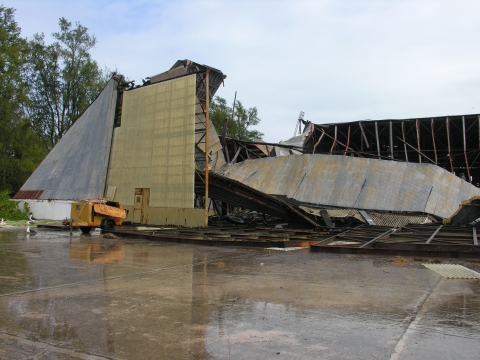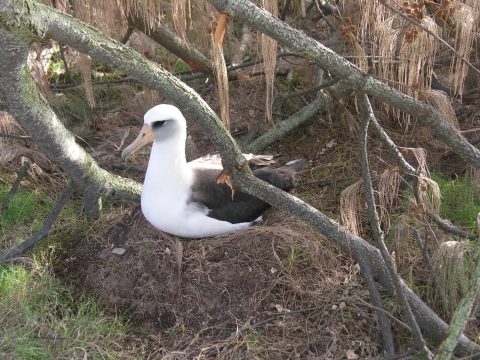On each New Year’s Day, Midway Atoll National Wildlife Refuge and Battle of Midway National Memorial is predominantly covered by over a million albatrosses and hundreds of thousands of their eggs — a marvelous sight seen nowhere else on the planet. But a different kind of winter visitor seems to also be making more regular landfalls — storms.
Since Dec. 1, 2021, Midway Atoll has been experiencing repeated high-wind storm events, some containing winds over 50 miles per hour that have impacted several species of seabirds and some of the World War II era buildings. Waves have overtopped seawalls and invaded the beaches, causing a large number of nest failures from eggs being washed away or nests being flooded. Hundreds of nests and eggs have been impacted. Falling trees and large branches have killed adult albatross and eggs.
Buildings also suffered some serious damage from the impacts of the strong winds and heavy rains. Sadly, the seaplane hangar collapsed on January 13 during a torrential downpour. The seaplane hangar had been enduring weeks of strong winds that gradually stripped siding of the structure structure
Something temporarily or permanently constructed, built, or placed; and constructed of natural or manufactured parts including, but not limited to, a building, shed, cabin, porch, bridge, walkway, stair steps, sign, landing, platform, dock, rack, fence, telecommunication device, antennae, fish cleaning table, satellite dish/mount, or well head.
Learn more about structure which was found scattered all around the albatross nesting grounds. This hangar for seaplanes was built in 1940 and it was one of the first buildings constructed for the U.S. Naval base. It housed 107 fighter planes during the Battle of Midway, when it was first damaged by Japanese battle ships. Only half of the original hangar was rebuilt after the attack. Over the years, the building has stood through several hurricanes and tsunamis. However, rain, wind, and salt air have been weakening the building for over eight decades. Though no longer standing, people will be able to learn about the sea plane hangar on the Midway Atoll website, virtual visits to the Refuge and Memorial, and educational opportunities.
The low-lying islands and atolls in the Monument are extremely vulnerable to sea level rise, with some low-lying islands averaging only 3.2 meters in elevation. Sea level at Midway Atoll rises at a rate of five millimeters per year, which is faster than the global average. This makes the impact of storms all the greater.
The majority of seabirds in the Pacific Islands nest at or near sea level, regardless of the maximum elevation of the island on which they nest. For albatrosses and other seabirds, some years are calmer than others when wintering at Midway Atoll. This winter has been a rough one for some seabirds with more frequent storms than usual at Midway Atoll. Even when exposed to winds over 50 miles per hour winds and torrential rain, albatrosses patiently sit through storms while devotedly incubating their eggs. Despite their fearless paternal instincts, some birds aren’t as lucky and won’t make it through the storms.
Sea level rise and surge from storms and tsunamis put seabird nests at risk of flooding. In the winter of 2011 a tsunami wreaked havoc on Midway Atoll and nearly 300,000 albatrosses’ nests were destroyed. Climate change and consequent processes such as increased storm intensity are difficult to predict accurately and may prove impossible to manage.
Midway Atoll is ecologically significant on a global scale. Altogether, nearly three million birds nest at Midway Atoll Refuge and Memorial each year, including the world’s largest population of albatrosses, nunulu (Bonin petrels), and endangered Laysan ducks.
To stem the loss of nesting habitat for seabirds, whose primary nesting islands in the Northwestern Hawaiian Islands may be lost to sea level rise, Pacific Rim Conservation and other partners are working with the Monument co-managers to create new, safe nesting sites for them on high-islands. Such proactive partnerships created to establish more secure seabird colonies on high islands within the historical nesting range, provide hope for these seabirds to not disappear from the Hawaiian Islands.
The co-managers from the Papahānaumokuākea Marine National Monument are working to better understand the implications sea-level rise is having on the wildlife and their habitat and the cultural resources. As the climate changes, these large expanses of ocean, remote atolls and islands are becoming even more important refuges for marine wildlife and seabirds.
Papahānaumokuākea is cooperatively managed to ensure ecological integrity and achieve strong, long-term protection and perpetuation of Northwestern Hawaiian Island ecosystems, Native Hawaiian culture, and heritage resources for current and future generations. Four co-trustees — the Department of Commerce, Department of the Interior, State of Hawai‘i and the Office of Hawaiian Affairs — protect this special place. Papahānaumokuākea Marine National Monument was inscribed as the first mixed (natural and cultural) UNESCO World Heritage Site in the United States in July 2010. For more information, please visit www.papahanaumokuakea.gov.
The U.S. Fish and Wildlife Service works with others to conserve, protect, and enhance fish, wildlife, plants, and their habitats for the continuing benefit of the American people. For more information, connect with us through any of these social media channels at https://www.facebook.com/PacificIslandsFWS, www.flickr.com/photos/usfwspacific/, or www.twitter.com/USFWSPacific.





